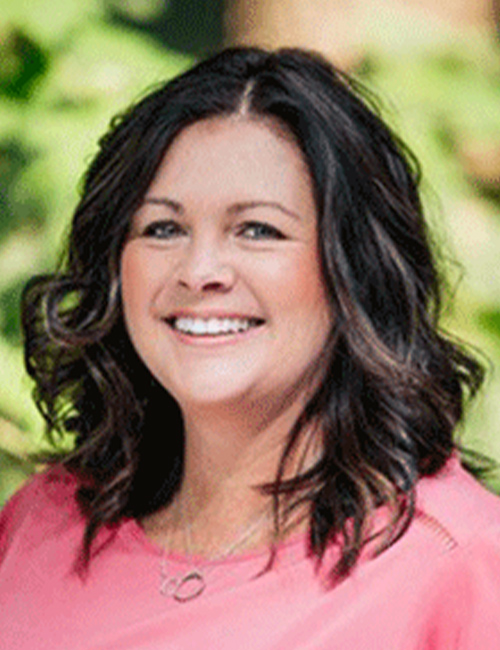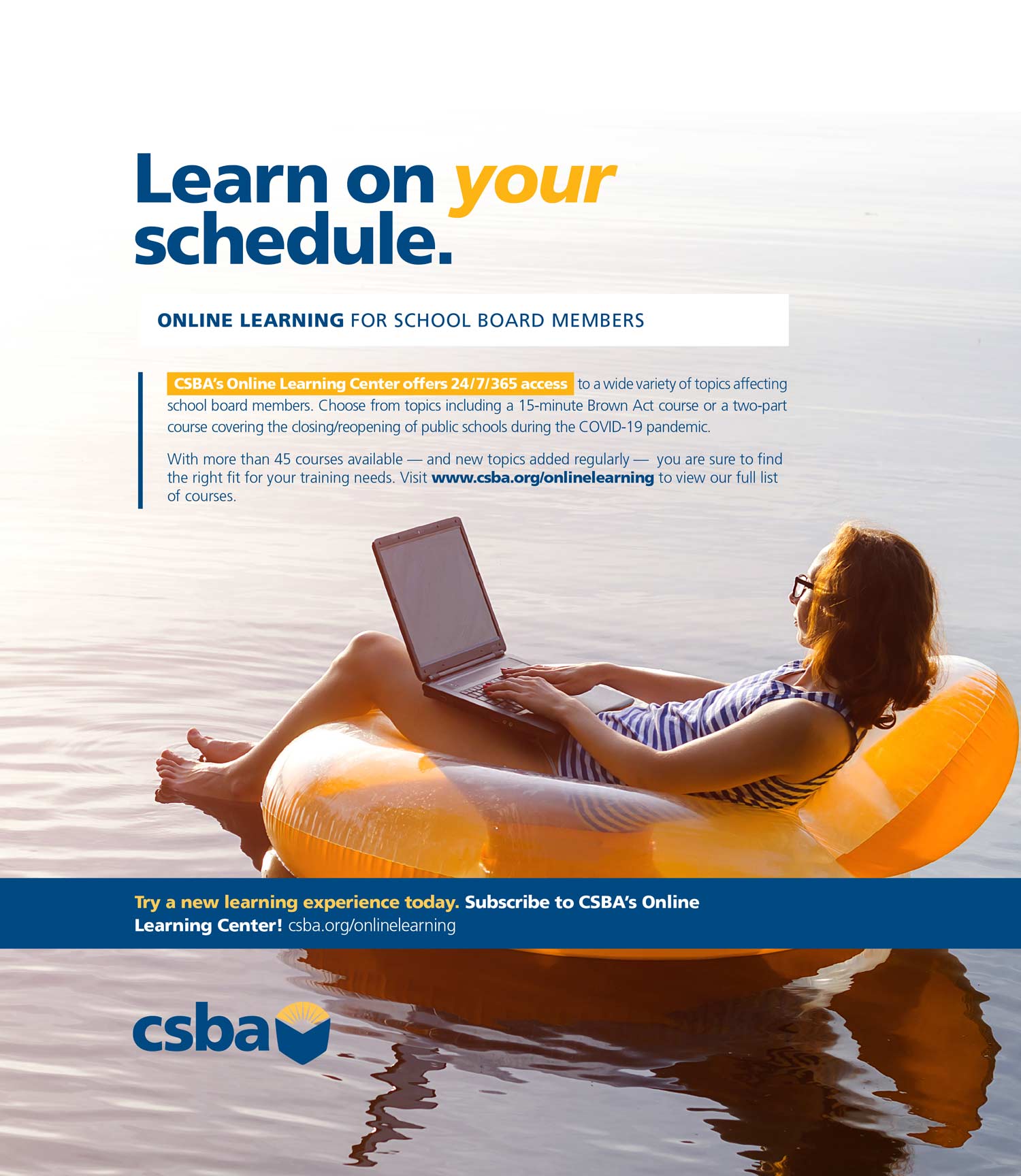
Spring 2021
Proposed guidance on COVID-19 testing presents major hurdle
by Alisha Kirby and Kimberly Sellery
Marketing schools in a competitive environment
by Kimberly Sellery
by Vernon M. Billy
by Keith Bray
by Angelena Pride, Amy Christianson and Teri Vigil
By Maureen O’Leary Burness
Interview with Chris Norwood

The Asian American experiences that deserve the attention of our schools
alifornia is home to the nation’s largest Asian American population, totaling 14 percent of its residents. Yet, while our state enjoys a reputation for embracing diversity, the reality of the current Asian American experience paints a different picture.
From March 2020 to May 2020, the Asian Pacific Policy Planning Council documented more than 800 COVID-related hate incidents against Californians of Asian heritage, and the pace has not slowed even as California has made progress against the virus.

Region 1, Del Norte County USD
Sherry Crawford
Region 2, Siskiyou COE
A.C. “Tony” Ubalde, Jr.
Region 3, Vallejo City USD
Renee Nash
Region 4, Eureka Union SD
Alisa MacAvoy
Region 5, Redwood City ESD
Darrel Woo
Region 6, Sacramento City USD
Yolanda Peña Mendrek
Region 7, Liberty Union HSD
Region 8, Manteca USD
Tami Gunther
Region 9, Atascadero USD
Kathy Spate
Region 10, Caruthers USD
Sabrena Rodriguez
Region 11, Ventura USD
William Farris
Region 12, Sierra Sands USD
Meg Cutuli
Region 15, Los Alamitos USD
Karen Gray
Region 16, Silver Valley USD
Region 17, Solana Beach SD
Wendy Jonathan
Region 18, Desert Sands USD
Albert Gonzalez
Region 20, Santa Clara USD
Scott Schmerelson
Region 21, Los Angeles USD
Nancy Smith
Region 22, Palmdale SD
Helen Hall
Region 23, Walnut Valley USD
Leighton Anderson
Region 24, Whittier Union HSD
Director-at-Large African American,
Monterey Peninsula USD
Crystal Martinez-Alire
Director-at-Large American Indian,
Elk Grove USD
Amy Koo
Director-at-Large Asian/Pacific Islander,
Belmont-Redwood Shores SD
Bruce Dennis
Director-at-Large County, Riverside COE
Joaquín Rivera
Director-at-Large Hispanic, Alameda COE
Rick Shea
CCBE President, San Diego COE
Region 1, Del Norte County USD
Sherry Crawford
Region 2, Siskiyou COE
A.C. “Tony” Ubalde, Jr.
Region 3, Vallejo City USD
Renee Nash
Region 4, Eureka Union SD
Alisa MacAvoy
Region 5, Redwood City ESD
Darrel Woo
Region 6, Sacramento City USD
Yolanda Peña Mendrek
Region 7, Liberty Union HSD
Stephen J. Schluer
Region 8, Manteca USD
Tami Gunther
Region 9, Atascadero USD
Kathy Spate
Region 10, Caruthers USD
Sabrena Rodriguez
Region 11, Ventura USD
William Farris
Region 12, Sierra Sands USD
Meg Cutuli
Region 15, Los Alamitos USD
Karen Gray
Region 16, Silver Valley USD
Debra Schade
Region 17, Solana Beach SD
Wendy Jonathan
Region 18, Desert Sands USD
Albert Gonzalez
Region 20, Santa Clara USD
Scott Schmerelson
Region 21, Los Angeles USD
Nancy Smith
Region 22, Palmdale SD
Helen Hall
Region 23, Walnut Valley USD
Leighton Anderson
Region 24, Whittier Union HSD
Bettye Lusk
Director-at-Large African American,
Monterey Peninsula USD
Crystal Martinez-Alire
Director-at-Large American Indian,
Elk Grove USD
Amy Koo
Director-at-Large Asian/Pacific Islander,
Belmont-Redwood Shores SD
Bruce Dennis
Director-at-Large County, Riverside COE
Joaquín Rivera
Director-at-Large Hispanic, Alameda COE
Rick Shea
CCBE President, San Diego COE

legal insights
California’s labor relations laws need flexibility during the state of emergency
he beat goes on for district and county board members and superintendents. For more than a year, they have been caught in a cycle of proposals, plans, guidance, orders and legislation aimed at safely reopening schools. Increasing the challenge faced by local educational agencies in complying with this ever-changing backdrop, and explaining the changes to stakeholders, is the fact that each change may trigger another round of collective bargaining. Unfortunately, in many cases, this cycle of constant change has worked to impede the reopening of schools.

Chief Information Officer
Troy Flint, tflint@csba.org
Managing Editor
Kimberly Sellery, ksellery@csba.org
Marketing Director
Serina Pruitt, spruitt@csba.org
Staff Writers
Andrew Cummins, acummins@csba.org
Alisha Kirby, akirby@csba.org
Graphic Design Manager
Kerry Macklin, kmacklin@csba.org
Senior Graphic Designer
Mauricio Miranda, mmiranda@csba.org
Circulation and Advertising
csba@csba.org
CSBA OFFICERS
President
Suzanne Kitchens, Pleasant Valley SD
President-elect
Dr. Susan Heredia, Natomas USD
Vice President
Susan Markarian, Pacific Union ESD
Immediate Past President
Xilonin Cruz-Gonzalez, Azusa USD
CEO & Executive Director
Vernon M. Billy
California Schools (ISSN 1081-8936) is published quarterly by the California School Boards Association, Inc., 3251 Beacon Boulevard, West Sacramento, CA 95691, (916) 371-4691. $2 of CSBA membership dues goes toward the subscription to California Schools magazine for each board member and superintendent. The subscription rate for each CSBA nonmember is $20. Periodicals postage paid at West Sacramento, CA and at additional mailing office. Postmaster: Send address changes to California Schools, 3251 Beacon Blvd., West Sacramento, CA 95691.
Articles submitted to California Schools are edited for style, content and space prior to publication. Views expressed are those of the authors and do not necessarily represent CSBA policies or positions. Articles may not be reproduced without written permission of the publisher. Endorsement by CSBA of products and services advertised in California Schools is not implied or expressed.




Dear Boardwise,
What are the best ways to communicate with our community during this pandemic?
Angelena: As school board members, this time of year is typically filled with a bustle of activities. Your calendar is usually packed with events you plan to attend in support of students, staff and community. Yet here we are, almost a year into the COVID-19 pandemic, trying to find ways to maintain contact with community members while adhering to COVID restrictions. How do we do it? Here are a few tips.
class act Best practices in action
Best practices in action

Best practices in action

Serving the district’s 72 schools, SWSS’ mission is to provide resources to build the social-emotional and relational capacity of students so they can be successful in their academic careers and personal lives.
n Februarys past, high school stadiums would be awash with the flood of lights, the crack of helmets and the resounding cheers; gymnasiums pierced by the squeak of tennis shoes and the thud of a volleyball hitting the wood after a solid spike.
But coaches, parents and student-athletes are pushing to get back into competition and start the high school sports season. A grassroots movement that originated on Facebook called “Let Them Play CA,” has organizing rallies across the state to advocate health officials to let kids play organized sports. And the Golden State HS Football Coaches Community met with officials from Gov. Gavin Newsom’s office on Feb. 2 to lobby for the California Department of Public Health to ease guidelines currently barring high-contact sports like football.

he California Commission on Teacher Credentialing (www.ctc.ca.gov) has worked diligently over the last five years to update its teacher credentialing system, following multiple recommendations from the California Statewide Special Education Task Force.


What inspired you to become a school board member?
I love Milpitas. I grew up in Milpitas. It’s helped raise me. I wanted to pay it forward. I had been involved in tutoring, coaching and volunteering in the community for over 20 years. Word of my leadership and passion for kids and education reached the ears of the school board president at the time, Mrs. Marsha Grilli. She asked me to run and I said no about five times. She said she wouldn’t stop calling me until I said yes. I also wanted to make my mom and wife proud. I wanted to set a unique example for my kids. I know it sounds cliche: we strive to be what we see.
What do you see as the role of public education?
The role of public education is to develop, inspire and challenge the minds of the learners it serves in their discovery of purpose and passion in the pursuit of happiness. It is also to serve our individual and collective societies greatest needs, common needs and economic investments needs for national longevity and prosperity. Public education should ensure its participants have the choice to become culturally and globally aware, anti-racist, empathetic to others and participate in the success of both local and national economic success. The last 12 months have provided opportunities to redesign the systems that can instead propel us forward in realizing our collective vision on education in a democracy.
Who or what inspires you as an adult?
I am inspired by faith. I am inspired by the potential of children. I am inspired by the adults who accepted the challenge of living outside of the normal boundaries of life and their comfort zones. I am inspired by the pursuit of purpose. A few people and organizations that have touched my heart profoundly include my mom, Zenobia Norwood; my wife, Arzee Norwood; the Greene Scholars Program and The Hidden Genius Project, among so many more.
What are the biggest issues you see facing our schools today?
The biggest issues I see preventing our schools from accelerating learning gains, creating new pathways and inspiring all learners are deep rooted in the comforts of tradition, antiquated systemic practices, policies, the equity versus equality debate and the ever-evolving funding formula. We are in the midst of the greatest opportunities for the advancement of California’s public education system in its history. We are experiencing multifaceted, multibillion dollar investments into modernizing our digital infrastructure; witnessing unprecedented levels of collaborative teacher professional development; and watching a new federal administration revisit racial equity with unprecedented intention. I believe our global academic ranking can match our global economic ranking if we took a regional approach.
What advice do you have for new or aspiring school board members?
Elected school board officials are part-time fiscal managers, community liaisons, representatives of the non-voters, voters and taxpayers of the district. Within a four-year term there are roughly 100 and 120 meetings. Often, the decisions made in these meetings immediately impact lives and livelihoods for years. It is an amazing opportunity to listen, learn and lead. At the beginning of my CSBA Board Member Golden Gavel Award acceptance speech during the CSBA 2020 virtual Annual Education conference I said, “Be the work. Do the work. Love the work. See the results.”



What inspired you to become a school board member?
I love Milpitas. I grew up in Milpitas. It’s helped raise me. I wanted to pay it forward. I had been involved in tutoring, coaching and volunteering in the community for over 20 years. Word of my leadership and passion for kids and education reached the ears of the school board president at the time, Mrs. Marsha Grilli. She asked me to run and I said no about five times. She said she wouldn’t stop calling me until I said yes. I also wanted to make my mom and wife proud. I wanted to set a unique example for my kids. I know it sounds cliche: we strive to be what we see.
What do you see as the role of public education?
The role of public education is to develop, inspire and challenge the minds of the learners it serves in their discovery of purpose and passion in the pursuit of happiness. It is also to serve our individual and collective societies greatest needs, common needs and economic investments needs for national longevity and prosperity. Public education should ensure its participants have the choice to become culturally and globally aware, anti-racist, empathetic to others and participate in the success of both local and national economic success. The last 12 months have provided opportunities to redesign the systems that can instead propel us forward in realizing our collective vision on education in a democracy.
Who or what inspires you as an adult?
I am inspired by faith. I am inspired by the potential of children. I am inspired by the adults who accepted the challenge of living outside of the normal boundaries of life and their comfort zones. I am inspired by the pursuit of purpose. A few people and organizations that have touched my heart profoundly include my mom, Zenobia Norwood; my wife, Arzee Norwood; the Greene Scholars Program and The Hidden Genius Project, among so many more.
What are the biggest issues you see facing our schools today?
The biggest issues I see preventing our schools from accelerating learning gains, creating new pathways and inspiring all learners are deep rooted in the comforts of tradition, antiquated systemic practices, policies, the equity versus equality debate and the ever-evolving funding formula. We are in the midst of the greatest opportunities for the advancement of California’s public education system in its history. We are experiencing multifaceted, multibillion dollar investments into modernizing our digital infrastructure; witnessing unprecedented levels of collaborative teacher professional development; and watching a new federal administration revisit racial equity with unprecedented intention. I believe our global academic ranking can match our global economic ranking if we took a regional approach.
What advice do you have for new or aspiring school board members?
Elected school board officials are part-time fiscal managers, community liaisons, representatives of the non-voters, voters and taxpayers of the district. Within a four-year term there are roughly 100 and 120 meetings. Often, the decisions made in these meetings immediately impact lives and livelihoods for years. It is an amazing opportunity to listen, learn and lead. At the beginning of my CSBA Board Member Golden Gavel Award acceptance speech during the CSBA 2020 virtual Annual Education conference I said, “Be the work. Do the work. Love the work. See the results.”
School
Reopening
The reality on the ground is much more complicated, however. Due to a shortage of available vaccines and often-fumbled distribution, it will be a while before all teachers, school staff and other essential workers are fully vaccinated — let alone students under the age of 16, for whom a vaccine has not even been approved for use.
For now, local educational agencies that reopen campus for small cohorts of higher-needs students or in a hybrid learning model must continue to rely on mitigation strategies that dictate good hygiene practices, social distancing, the proper use of personal protective equipment and regular testing.

School
Reopening
The reality on the ground is much more complicated, however. Due to a shortage of available vaccines and often-fumbled distribution, it will be a while before all teachers, school staff and other essential workers are fully vaccinated — let alone students under the age of 16, for whom a vaccine has not even been approved for use.
For now, local educational agencies that reopen campus for small cohorts of higher-needs students or in a hybrid learning model must continue to rely on mitigation strategies that dictate good hygiene practices, social distancing, the proper use of personal protective equipment and regular testing.
is that last, critical factor that has proven to be a significant challenge for districts. Currently, most LEAs are providing surveillance testing for staff only, typically once every two months, and are doing so based on the July 17, 2020, guidance from the California Department of Public Health.
COVID-19 testing for students and staff is central to the Gov. Gavin Newsom’s proposed Safe Schools for All reopening plan and is likely to be a factor in any widescale reopening plan introduced by lawmakers and CDPH officials. Ramping up testing to cover all staff and students will require an unrealistic amount of infrastructure, staffing, new billing operations, private and state lab capacity, testing contracts, collection and transportation of tests, and additional employee negotiations due to changes in working conditions. In addition, the use of Proposition 98 funds for public health initiatives is inappropriate and would detract from much-needed resources for student social-emotional health and accelerated learning.


the cte playbook:



 ow many children have immediate access to a 3-D printer? Or a spare car engine and the tools needed to restore it? How do courses in biomedical technology, engineering or robotics, which require significant work with resources and supplies that are not common household items, translate to an online setting?
ow many children have immediate access to a 3-D printer? Or a spare car engine and the tools needed to restore it? How do courses in biomedical technology, engineering or robotics, which require significant work with resources and supplies that are not common household items, translate to an online setting?
In some districts, the transition has gone better than could have perhaps been expected — though not without challenges.
“Sometimes I think it takes something significant to really shake things up,” said MJ Cooke, Anaheim Innovative Mentoring Experience program director for the Anaheim Union High School District. The program — a 2020 Golden Bell recipient — prepares students for college and career by providing mentoring opportunities across four tiers that include career exploration, guest speakers, field trips, a mentoring series and internships.
Congratulations
The following graduates have successfully completed the 2020 virtual MIG program, gaining essential knowledge for being an effective governance team member.

I give a lot of credit to the school districts that really stepped up and made it their business to do what they can to keep in touch with kids. We got approval from (Sacramento County Public Health) to allow for emergency in-person counseling as needed in severe cases where students could do one-on-one counseling after school. It’s got to be based on the judgment of the personnel who’ve been in touch with the child and, if appropriate, the family.






























